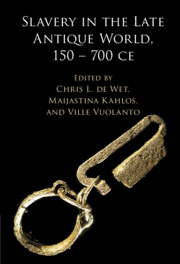Book contents
- Slavery in the Late Antique World, 150–700 CE
- Slavery in the Late Antique World, 150–700 CE
- Copyright page
- Contents
- Figures
- Tables
- Contributors
- Preface
- A Note on Abbreviations and Sources Used
- Introduction Late Antique Studies and the New Polyphony for Slave Studies
- Part I Moral and Symbolic Values of Slavery
- Part II Slavery, Cultural Discourses, and Identity
- Part III Slavery, Social History, and the Papyrological and Epigraphical Sources
- Part IV Social and Religious Histories of Slavery on the Borders of the Empire and Beyond
- 12 Slavery among the Visigoths
- 13 Sinner, Slave, Bishop, Saint: The Social and Religious Vicissitudes of St Patrick
- 14 Slave Boys in Paradise? The Text of the Quran and Its Later Exegetes
- Bibliography
- Index
14 - Slave Boys in Paradise? The Text of the Quran and Its Later Exegetes
from Part IV - Social and Religious Histories of Slavery on the Borders of the Empire and Beyond
Published online by Cambridge University Press: 27 January 2022
- Slavery in the Late Antique World, 150–700 CE
- Slavery in the Late Antique World, 150–700 CE
- Copyright page
- Contents
- Figures
- Tables
- Contributors
- Preface
- A Note on Abbreviations and Sources Used
- Introduction Late Antique Studies and the New Polyphony for Slave Studies
- Part I Moral and Symbolic Values of Slavery
- Part II Slavery, Cultural Discourses, and Identity
- Part III Slavery, Social History, and the Papyrological and Epigraphical Sources
- Part IV Social and Religious Histories of Slavery on the Borders of the Empire and Beyond
- 12 Slavery among the Visigoths
- 13 Sinner, Slave, Bishop, Saint: The Social and Religious Vicissitudes of St Patrick
- 14 Slave Boys in Paradise? The Text of the Quran and Its Later Exegetes
- Bibliography
- Index
Summary
The issues of slavery in classical Islamic law and thought as well as the social reality of slaves and ex-slaves (clients) in the medieval Near East have been gaining increased attention in recent decades. Much remains to be done, however. For instance, I am not aware of any specific study (book or article) focusing on slavery and slaves in the Quran or Quranic environment. I will begin this chapter by briefly discussing the Quranic passages that have a bearing on slavery in the late antique Arabian context before moving on to deal in detail with one specific verse, Quran 52:24, which seems to suggest that, in fact, there might be slaves in the afterlife serving the believers. The crux of the matter is the interpretation of the expression ghilmān lahum, which could be understood as ‘slave boys belonging to them’, ‘young servants of theirs’, or simply ‘children of theirs’.
Keywords
- Type
- Chapter
- Information
- Slavery in the Late Antique World, 150 – 700 CE , pp. 298 - 315Publisher: Cambridge University PressPrint publication year: 2022

